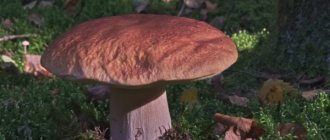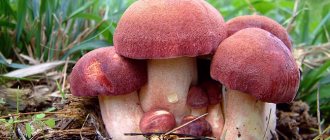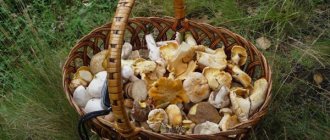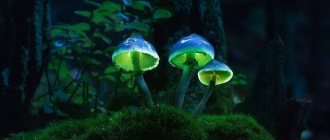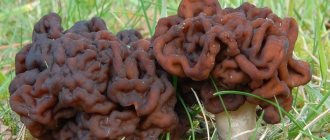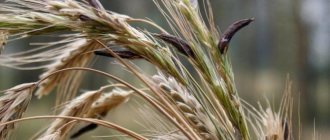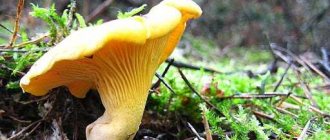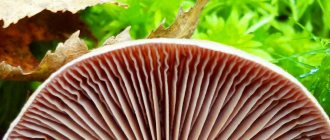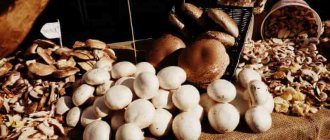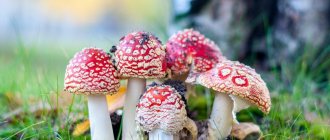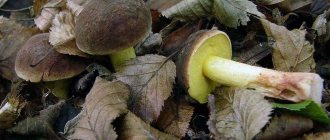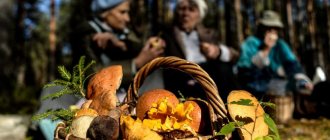Indeed, the activity is very exciting and interesting, which also allows you to feast on the harvest. However, you need to know about mushrooms so that poisonous ones do not end up in the basket along with edible ones, which, if eaten, can cause severe food poisoning. Edible mushrooms with photos, names and descriptions are offered for review by anyone interested in collecting mushrooms.
Description of alder pig
The diameter of the alder pig's cap varies from medium to large sizes - 5-15 centimeters. The color of the cap is yellow-brown, red-brown or ocher-brown. The shape of the cap at the initial stage of growth is convex with a folded thin edge, and over time it transforms into a flat one with a depressed center with a straight edge. The surface of the cap is felt, dry. The cap can be smooth or with dark scales. The scales can be both ingrown and lagging.
The plates are narrow, soft, and located at a medium frequency. The shape of the plates is forked; there are bridges at their base. The color of the plates is yellowish, somewhat lighter than the cap. When pressed, the plates turn brown. The pulp is dense but soft; later it becomes loose. The color of the pulp is yellow, it darkens when cut.
The length of the leg is most often 2-5 centimeters, occasionally reaching 7 centimeters, and its thickness is up to 1.5 centimeters. The leg is located in the center of the cap. Towards the base it becomes somewhat narrowed. The surface of the leg is felt, the same color as the cap. When pressed, the leg darkens a little.
Places where alder pigworts grow
This mushroom got its name because it prefers to live under alder and aspen trees. Alder pigworts bear fruit from July to September. They are found in deciduous forests. These mushrooms are rarely found. They grow in groups and can form circles.
Similarity of alder piglet with other species
Alder pig has an external resemblance to thin pig. But the alder piglet differs in its scaly cap and more reddish hue. Another difference between these species is where they grow.
Evaluation of alder hogweed
Today, the alder pig, like the thin pig, is classified as a poisonous species. But in some sources it still appears in the category of conditionally edible mushrooms. Pig mushrooms were officially classified as inedible mushrooms in 1984. The composition of their pulp has been studied for many years, and it has been reliably established that these are dangerous poisonous mushrooms.
The pulp of alder pig contains poison - muscarine. This poison is so persistent that it is not even neutralized after 3 hours of cooking. There is no point in cooking mushrooms after boiling for such a long time, since they turn into a slimy mass.
The potency of muscarine contained in pigs is twice as strong as that of red fly agaric mushrooms. When eating alder pigs, acute or chronic intoxication develops. If the dose of mushrooms is large, then poisoning occurs half an hour after eating.
The victim's salivation increases, weakness occurs, dizziness, sweating appears, blood pressure drops, and pulse weakens. Then vomiting begins, severe pain appears in the abdomen and frequent diarrhea begins. With a large dose of the toxin, there is a risk of developing pulmonary and cerebral edema. If the victim does not see a doctor, there is a high risk of death.
Not long ago, another threat to lovers of dubious mushrooms was identified. Based on the results of a large number of experiments, it became known that the pulp of pigs contains a high concentration of protein-antigen. These proteins cause irreversible damage to red blood cells. The effect of protein causes red blood cells to stick together. That is, a person’s blood can instantly clot, and blood clots in the vessels or heart muscle can lead to death.
Antigen proteins can accumulate in tissues for many years. They enter the body in small quantities from time to time and gradually accumulate. As a result, a person develops anemia and various thromboses, which are difficult to associate with food poisoning. The cause of death in this case is a sudden stroke or heart attack, which is not directly related to food intoxication.
Is it worth the risk to eat pigs that do not have excellent taste?
Other mushrooms of this genus
Thin mushroom is a poisonous mushroom. The cap is fleshy, large - up to 15 centimeters in diameter, slightly convex in shape, and then funnel-shaped. The edge of the cap is felted and velvety. The color of the cap is olive-brown or buffy-brown. The skin of the cap is bare. The pulp is loose, soft, yellowish in color, turning brown when cut. The height of the leg can reach up to 9 centimeters. Its structure is dense and its shape is cylindrical.
Slender pigweeds grow most often in young birch forests, but are also found in deciduous and broad-leaved forests. They can be found along the edges of swamps and ravines, in clearings and forest edges. They come across often and grow abundantly in groups. They bear fruit in June-October.
Fat pig is a poisonous mushroom. The diameter of the cap is 8-20 centimeters. The color of the cap is olive-brown or brown. At first the cap is velvety, but with age it becomes bare. Its shape varies from convex to tongue-shaped. The edges of the cap are slightly curled inward. The knife is short, thick and fleshy. The surface of the leg is felt. The pulp is watery. The color of the pulp is yellow.
Fat pigs are rare. Fruiting begins in July and continues until late autumn. Fat pigs grow singly or in small groups. They settle on the ground, or on roots and stumps.
Seasonality
Most often, pigs are found on forest edges and clearings, as well as on the outskirts of swamps. Often small groups of pigs take a liking to the rhizomes of trees, uprooted after strong winds. Svinushka is characterized by a long period of fruiting; it can be found from July to early October. The sow mushroom, like all mushrooms, reproduces by spores.
Interesting read: Thin pig
Alder moth (Pholiota alnicola)
Taxonomy:
- Division: Basidiomycota (Basidiomycetes)
- Subdivision: Agaricomycotina (Agaricomycetes)
- Class: Agaricomycetes (Agaricomycetes)
- Subclass: Agaricomycetidae (Agaricomycetes)
- Order: Agaricales (Agaric or Lamellar)
- Family: Strophariaceae
- Genus: Pholiota (Scaly)
- Species: Pholiota alnicola (Alder moth (Alder scale))
or
Alder scale
Alder moth (lat. Pholiota alnicola ) is a species of mushroom included in the genus Pholiota of the Strophariaceae family.
Grows in groups on stumps of alder and birch. Fruiting - August-September. It is found in the European part of Russia, the North Caucasus, and the Primorsky Territory.
The cap is 5-6 cm in ∅, flat-convex, yellow-ocher, with brown scales, with remnants of a membranous cover in the form of thin flakes along the edge of the cap.
The pulp is yellowish. The plates are adherent, dirty yellow or rusty.
Leg 4-8 cm long, 0.4 cm ∅, curved, with a ring; above the ring - pale straw, below the ring - brown, fibrous.
The mushroom is inedible. May cause poisoning.
Photo of the mushroom Alder moth (Alder scale)
from questions in recognition:
Spread of the fungus
Paxillus rubicundulus.
Settles mainly under aspen and alder trees. Found in deciduous forests of Russia and some European countries. It usually grows in groups. Sometimes it forms witch circles - one or more rings of mushrooms.
It grows from mid-summer to September inclusive.
The pig is thin.
Description
This is a rather rare poisonous species that is found mainly under alder and aspen, which is why it received its corresponding name.
hat
Quite large - from 5 to 15 cm in diameter. The color is yellow, orange, light brown or brown. Young mushrooms have a convex cap, while the edges bend. In mature representatives it becomes flat, the edges straighten, and a small depression forms in the center.
The surface is dry, smooth, and often has dark-colored scales. They may be ingrown or slightly behind the surface. Under the cap there are yellowish plates If you press, they will turn brown. The pulp is dense, but has a soft consistency. It is yellow when cut and quickly begins to darken. Gives a pronounced mushroom aroma.
Leg
Small (up to 5-7 cm in height) and relatively narrow (up to 1.5 cm in diameter). Cylindrical, slightly tapering towards the base. The surface is smooth, basically has the same color as the cap, but may be lighter. It darkens a little when pressed.
Spore powder
Painted in red-brown colors.
List of forest edible mushrooms with photos and tips for novice mushroom pickers
Mushrooms are considered edible; they can be used as food with absolutely no risk to life and health, since they have significant gastronomic value, are distinguished by a delicate and unique taste; dishes made from them do not become boring and are always in demand and popularity.
Good mushrooms are called lamellar, on the underside of the caps there are lamellar structures or spongy, since their caps on the underside resemble a sponge, inside of which there are spores.
When picking, experienced mushroom pickers always pay attention to special signs that a mushroom is edible:
frequency of the plates;- what color are the spores;
- how the plates are attached to the leg;
- change in color of the pulp when pressing on it.
Forest mushrooms grow from a mycelium that resembles a grayish light mold that appears on a rotting tree. Delicate fibers of the mycelium intertwine the roots of the tree, creating a mutually beneficial symbiosis: the mushrooms receive organic matter from the tree, and the tree receives mineral nutrients and moisture from the mycelium. Other types of mushrooms are tied to tree species, which later determined their names.
The list contains wild mushrooms with photos and their names:
- boletus;
- registry;
- boletus;
- subdukovik;
- pine mushroom;
- speckled oak or common oak, others.
In coniferous and mixed forests there are many other mushrooms that mushroom pickers are happy to find:
- chanterelles;
- saffron milk caps;
- honey mushrooms summer, autumn, meadow;
- boletus;
- Champignon;
- Russula;
- milk mushrooms;
- Polish mushroom, and so on.
During harvesting, it is best to place mushrooms in special wicker baskets, where they can be ventilated; in such a container it is easier for them to retain their shape. You cannot collect mushrooms in bags, otherwise, after returning home, you may find a sticky, shapeless mass.
It is allowed to collect only those mushrooms that are definitely known to be edible and young; old and wormy ones should be thrown away. It is better not to touch suspicious mushrooms at all and avoid them.
The best time to collect is early in the morning, while the mushrooms are strong and fresh, they will last longer.
Edibility of flywheel
Among the moss mushrooms there are both edible and inedible. Edible species are used as food without prior boiling for first courses, salting, pickling and drying. The entire mushroom is used in cooking: both the cap and the stem. The skin from the cap is removed and the stem is cleaned. To improve the absorption of mushrooms, they are thoroughly crushed. Dried moss mushrooms acquire a beautiful golden hue and a pleasant smell.
Moss mushrooms are rich in easily digestible proteins, sugars, enzymes and essential oils; they also contain vitamins A, B, B2, C, D and PP.
In addition, flywheels contain specific substances that quickly darken in air and spoil the appearance of the mushroom. Therefore, before cooking, mushrooms need to be processed quickly so that they are not exposed to air for a long time in their purified form; they are immediately placed in water. When boiling, add a teaspoon of salt and half a teaspoon of citric acid per liter of water.
Signs
Edible mushrooms are mushrooms that do not require special processing and can be cooked and eaten immediately. Edible mushrooms do not contain any toxic substances that can harm the body; they are absolutely safe for humans.
The nutritional value of edible mushrooms falls into four categories, from high-grade to low-grade mushrooms.
In order to distinguish edible mushrooms from inedible ones, you need to know some common distinguishing features:
- edible mushrooms do not have a specific pungent odor;
- the color of edible mushrooms is less bright and catchy;
- edible mushrooms usually do not change color after the cap is cut or broken;
- the flesh may darken when cooked or broken;
- In edible mushrooms, the plates are attached to the stem more firmly than in inedible ones.
All these signs are conditional and do not provide an exact guarantee that the mushroom is edible.
The video clearly shows how to distinguish edible mushrooms from poisonous ones using the example of the most common mushrooms. It also tells you what to do in case of poisoning:
On a note
The boletus mushroom has a very bright taste and aroma; it goes well with potatoes, onions, garlic, black pepper, dill, meat, green beans and carrots.
The best dishes made from alder pig are fried potatoes with mushrooms, pickled mushrooms with black peppercorns and garlic, pies with mushrooms, and pizza.
After pre-processing, alder mushrooms are prepared like any other; you can use all recipes, even freeze them (fresh mushrooms cannot be frozen).
Never neglect the preparation of conditionally edible mushrooms, so as not to get food poisoning instead of enjoying a great dish.
Source
Time and place of fruiting
This species is common in Europe and North America.
These groups of fungi are representatives of the soprotrophic group, which prefers to live on rotten wood and dead wood of coniferous trees, such as pine or spruce. The moth bears fruit on rotten stumps or near them, on the roots. In this case, it seems that the mushrooms grow from the ground. These are very common fruiting bodies, growing in bunches in coniferous or mixed forests, and are also found in deciduous ones.
Gymnopil pine and related species bear fruit from September to the end of November. Quite often, the peak of growth corresponds to the time when the winter honey fungus begins to appear.
If you have to turn to reference books for mushroom pickers for information in order to find out about the differences between the types of gymnopile, you will find complete confusion. Some will argue that Gymnopilus pine has a scaly cap, while Gymnopilus penetrating has a slightly pubescent cap or is generally smooth and bare. Other sources and descriptions will give completely opposite information. Still others present Gymnopil hybrid as a mushroom, identical to pine.
Growing flywheel at home
To grow moss at home, you need a shady area and a substrate consisting of branches, leaves, and humus. The soil can be taken from places where mushrooms naturally grow.
The substrate is placed in a heap in a trench up to 30 cm deep. Mature flywheel mushrooms are soaked in clean water. After a day, they are kneaded to a pulp. Then water is added to it and the mixture is poured evenly over the area.
During the first two months, the site needs abundant watering. Moss mushrooms are sown at the end of June.
The first harvest appears a year later.
About Ramaria in brief
Discovered in 1790, the genus Ramaria (from Latin Ramus means “branch”) is a genus of higher mushrooms from the family and order Gomphoraceae.
Fragile and leathery, the fruiting bodies of this genus are often characterized by medium (very rarely large) sizes and a highly branched shape (fork-shaped, fragile ends), gelatinized structure and very bright color (young fruits have a gradient, while older ones are monochromatic). Ellipsoidal spores range in size (that is, they can be both large and small), they are often hairy and covered with warts, and are least common with a smooth shape.
This genus includes more than two hundred species, among which you can find both saprophytes (settled on rotting structures, such as stumps and fruits) and those growing on the soil. And even though the fruits of this genus are often only conditionally edible (and almost never poisonous and dangerous in general), there are plenty of dangerous fruits in this genus. For example, mushrooms such as Ramaria beautiful and Ramaria light can cause nausea and diarrhea.
One of the most striking representatives of this genus is considered to be horned fruits of the type - yellow Ramaria or, in common parlance, deer horns.
Interesting Facts
Studies of the pulp of this mushroom have shown that it contains muscarine. This is a stable substance that retains its structure even after 3 hours of continuous cooking. Moreover, the poison has a very strong effect - its activity is 2 times higher than that of the toxins that make up the red fly agaric. As a result, within 1-2 hours after eating a person begins to develop symptoms of poisoning - weakness, dizziness, sweating, decreased blood pressure, pulse, vomiting, etc.
Alder pig poisoning
Alder pig eaten as food can cause poisoning, accompanied by mild or severe symptoms:
- vomiting;
- increased salivation and sweating;
- nausea;
- decreased blood pressure;
- diarrhea;
- abdominal pain;
- weakness;
- dizziness.
Antigens of the fungus, accumulating in the body, cause anemia, kidney and liver failure, which can result in a sudden and inexplicable death after decades.
